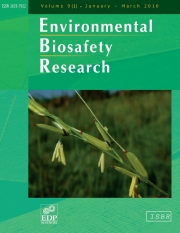Article contents
An attempt to identify recombinants betweentwo sobemoviruses in doubly infected oat plants
Published online by Cambridge University Press: 19 September 2006
Abstract
Recombination in RNA viruses is considered to play a major role as a driving force in virus variability to counterbalance loss in fitness that can be due to the accumulation of detrimental mutations. Studies on mixed infections are pertinent for understanding the role of recombination in virus evolution. They also provide important baseline information for studying the biosafety of plants expressing viral sequences. To investigate the possibility of RNA recombination occurrence between two sobemoviruses under little or no selection pressure, we co-infected test plants with Cocksfoot mottle virus (CfMV) and Ryegrass mottle virus (RGMoV). CfMV and RGMoV were selected because of their overlapping host range and geographical distribution. First, symptom development of both viruses in barley (Hordeum vulgare) and oat (Avena sativa) was examined. Both viruses generated quite strong infection symptoms in oat, but synergism was not detected. RGMoV was lethal for barley, whereas CfMV infection in barley was nearly symptomless. RT-PCR analysis revealed 100% infection with both viruses in oat but not in barley. Therefore, an RNA recombination study of CfMV and RGMoV was performed in oat. 105 plants were co-inoculated with both viruses and putative recombinational hot spot regions were screened for recombination events by RT-PCR analysis at a sensitivity level down to 0.1–100 pg of viral genomic RNA. No recombination events between the two sobemoviruses were detected.
Information
- Type
- Research Article
- Information
- Copyright
- © ISBR, EDP Sciences, 2006
References
- 4
- Cited by

